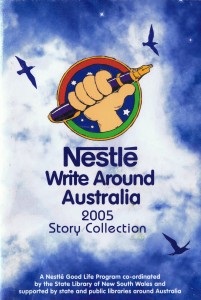I’ve always been primarily a fiction reader, but as I’ve gotten older, I’ve found a real interest in and attraction to memoir, and to certain types of non-fiction associated with personal stories. I’ve always liked biography, and indeed, as a young person a lot of the fiction I read (in late primary school, early high school in particular) was historical fiction about real people—Jean Plaidy‘s seemingly endless series of fictional re-imaginings of the lives of queens and princesses, mistresses and the men who loved and (too often) done them wrong (I’m looking at you, Henry Vee One One One).
These days, I mostly seem to gravitate towards memoir by writers, or other artists. I think one of the first books of this kind I really got fascinated by was Home: The Story of Everyone Who Ever Lived In Our House by Julie Meyerson. 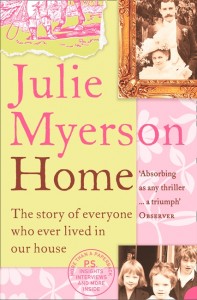 I first heard about the book when I heard an interview with Meyerson, I think on Radio National, and it seemed to me to be exactly the kind of book I would absolutely love, bringing together as it did history, domestic architecture, and the stories of real people’s lives. Foolishly, though, I didn’t write the name of the book or the author down, and it took me quite a few years before I finally tracked down a copy. And by the time I had, Meyerson had written (and lived through the fallout of) The Lost Child: A True Story*, about her son’s drug addiction and the impact it had on the family. I have a tendency to google everything I am reading/watching/listening to—I’m a bit of a bowerbird of
I first heard about the book when I heard an interview with Meyerson, I think on Radio National, and it seemed to me to be exactly the kind of book I would absolutely love, bringing together as it did history, domestic architecture, and the stories of real people’s lives. Foolishly, though, I didn’t write the name of the book or the author down, and it took me quite a few years before I finally tracked down a copy. And by the time I had, Meyerson had written (and lived through the fallout of) The Lost Child: A True Story*, about her son’s drug addiction and the impact it had on the family. I have a tendency to google everything I am reading/watching/listening to—I’m a bit of a bowerbird of knowledge trivia gossip OK I like to research!—and so once I found Home, I started reading up about Meyerson, and so had read all of the reviews, opinion pieces and general character assassination that she copped for writing about her child in such a brutal and honest way.
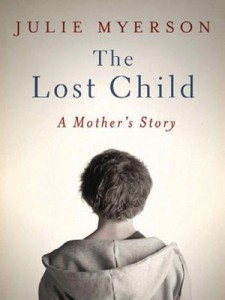 So there I was, reading Home, in which the son figures (as do all of the members of Meyerson’s family, as they had done in previous anonymous columns about her family life before she was outed), pre- his drug addiction and the incredible damage wrought within that family. (Whoever’s side you take on this—and believe me, I have read plenty of arguments for and against people, particularly mothers, writing about their children, to which I will return—I think there can be no dispute that this was a family in agony, and inflicting all kinds of terrible hurt on one another, parents and children alike. The question is, is anyone—especially mothers—ever allowed to write about that stuff, or is it, as was said in Meyerson’s case, the worst of the worst possible betrayal?)
So there I was, reading Home, in which the son figures (as do all of the members of Meyerson’s family, as they had done in previous anonymous columns about her family life before she was outed), pre- his drug addiction and the incredible damage wrought within that family. (Whoever’s side you take on this—and believe me, I have read plenty of arguments for and against people, particularly mothers, writing about their children, to which I will return—I think there can be no dispute that this was a family in agony, and inflicting all kinds of terrible hurt on one another, parents and children alike. The question is, is anyone—especially mothers—ever allowed to write about that stuff, or is it, as was said in Meyerson’s case, the worst of the worst possible betrayal?)
Anyway, the point is, the act of reading Home, knowing the fate of that child and this family, was almost an act of time travel, and it added a layer of fascination, perhaps even prurience to my reading, which simply would not have been there had I picked it up the day after that Radio National interview and not five years later. I remember I kept going back to google Meyerson as I read Home, to read about those early columns, trying to probe down beneath what I was reading in Home about these people, and trying to figure out how I felt about her act of writing about her family, and trying to unpick how much of what she went through as a writer was because of her status as a mother.
The other thing about me, and about why I knew I’d love Home, quite before I knew about and quite apart from the business with her son, is that I am quite snoopy about people’s private lives. I don’t mean people I know so much—I’ve just always loved, for instance, sneaking peeks into people’s homes as I walk past. I imagine the lives going on in those lit rooms, behind those doors and in the teasing glimpses f movement behind curtains. New Orleans was a dream come true for me—not only did I adore the architecture (and the more interesting the look of the house, the more interested I am in the people who live there), but those houses come right up to the footpath, and it’s so hot and steamy people keep their doors and windows wide open. Heaven for a peeping tom tourist.
And so reading about that Home, a Victorian terrace about the same age (I thought then) as the house I had bought about the same time I read the book, and all the people who ever lived there, was a perfect fit and an inspiration for me—and a double whammy, unexpectedly, when it came to prying into people’s lives.
And yes, I did go on to read The Lost Child. D’oh. (I also toyed with researching everyone who ever lived in my house, and I may still well do that one day.)
I’ve not read any of Meyerson’s fiction, although I have copies of at least a couple of her novels. The funny thing is, I actually love reading memoir by writers, but it doesn’t necessarily mean that I have had to have read their fiction or other work to be interested.
Because somewhere along the line, when writers write memoir, it becomes about the act of writing itself. And that’s what I think I am really drawn to. Jeanette Winterson‘s (whose fiction I have, as it happens, read, and loved) Why Be Happy When You Could Be Normal is a case in point. I adored this book. I kept wanting to copy out bits of it, mostly the stuff she had to say about writing—copy it out because I can’t bring myself to write in books—but I recall I read most of it in the bath, where I do a lot of my reading, and it’s hard enough to keep book, phone (got to have access to google, remember!) and cats all dry without trying to also make annotations.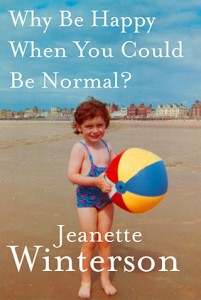
Winterson’s book did attract some criticism for more or less being a rehash of Oranges are Not The Only Fruit, and of the many stories Winterson has told in interviews and so on over the years about Mrs Winterson and the terrible madness of her parenting of the young Jeanette, but for me, that missed the point of the book. Yes it was a revisiting of earlier material, but that material was cast in the light of Winterson being at that stage in her life and career where she could explicitly frame that story and that life within her craft as a writer. It’s as if her understanding of her craft and her ability to elucidate it became the palimpsest of her own work. And I love that stuff. Google-addict, remember. Research. Thwarted, perhaps, PhD student. Anyway, we’ll see.
All of which brings me to the reason I first wanted to write this post—which was to reflect on two books I have recently read. There are themes intersecting here, especially about motherhood and memoir, but also about artistry and memory.
The first book is Boomer and Me: A Memoir of Motherhood and Asperger’s, by Jo Case. Disclaimer: I have known Jo via social media for a few years now, and we’ve become good friends via Facebook, sharing war stories of a personal experience we’ve each gone through, and which I won’t go into here. And she commissioned me to write a piece for the Wheeler Centre website earlier this year, so I have a number of reasons to be well-disposed towards her book. I would also say I find it difficult to imagine how I would have responded to the book if I didn’t know Jo—quite differently, I am quite sure, which is not to say better or worse, but certainly differently. So I write the following from that position of a sort-of friend of the writer. (And yes, I have met her IRL, as the young folk say; at the recent Sydney Writers’ Festival where we shared a coffee and conversation with another online writer friend, James Tierney, who also wrote the review of Jo’s book I linked to above.)
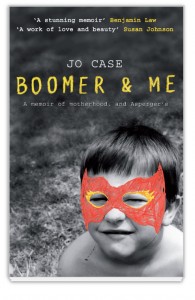 I wanted to read Boomer and Me as soon as I heard about it, not because I knew Jo (I know lots of writers whose books I haven’t read!), but because I have a number of friends and colleagues with children with Asperger’s, and this, as well as being a teacher and someone who works with young people, has given me an interest in how the condition manifests in different ways, and how people, and families, manage. Of course, every one of those children and families are different, and a book such as Boomer and Me can only every tell that one story, but also for me, if that’s the only story it tells, then it’s not likely to hold my interest.
I wanted to read Boomer and Me as soon as I heard about it, not because I knew Jo (I know lots of writers whose books I haven’t read!), but because I have a number of friends and colleagues with children with Asperger’s, and this, as well as being a teacher and someone who works with young people, has given me an interest in how the condition manifests in different ways, and how people, and families, manage. Of course, every one of those children and families are different, and a book such as Boomer and Me can only every tell that one story, but also for me, if that’s the only story it tells, then it’s not likely to hold my interest.
I loved Jo’s book. There’s an easy and pleasing style to her writing; it’s neither laboured nor self-conscious, and for me it somehow struck a balance between intimacy and privacy. At times, I felt like I was standing in the house, watching Jo make cups of tea, or pour glasses wine of wine, navigate her son Felix’s (a pseudonym) Lego and life, as her own life is revealed to her as Felix’s condition is diagnosed. I don’t know suburban Melbourne terribly well, but Jo captures the flavour of that city, where everyone seems to live within walking, or biking distance of one another, and there’s always some bit of book business going on to attend. Because Jo works in the industry, having worked for bookshops and Australian Book Review and now for the Wheeler Centre, and dammit, Melbourne is such a hive of book folk and their goings on, and from my vantage point on the far outskirts of Sydney, it was a delight to double with Jo in her bike, peer over her shoulder as she struggled with the latest draft of her WIP, and to be her ‘plus one’ as she moves around that City of Literature.
But it’s by no means a book of book biz luvvies, either, I don’t think I could have stood that. One thing that shone for me was the school dynamics Jo captures so beautifully—the classroom and playground politics, the passive-aggressive parent who always has some complaint to make about Felix’s behaviour but cannot see her own child’s complicity in the naughtiness. The teachers, wonderful and clueless. And then the doctors and psychologists, and Jo’s growing awareness that what sets apart her boy might also explain some thing about her own family… and herself.
And at the heart of it all, this boy, this lovely boy, big-hearted and slightly off-kilter, and so vulnerable, precisely because he has no way of knowing why he’s vulnerable to over-protective parents and kids and, indeed, a world which so often doesn’t, won’t tolerate difference.
There’s a scene where Jo and Felix move back into a house where Felix’s father once lived, and Felix reconnects with Steven, the boy who lives next door, a one-time best friend he’s lost touch with since his dad moved. I confess I was terrified that Steven or Steven’s parents would no longer want this friendship, now that Felix was grown up and into his personal eccentricities—all of this in the shadow of that other parent who was so unforgiving of him. I often get that sensation of holding my breath when I’m reading something suspenseful, and this was exactly that for me. (I won’t tell you how it all pans out. Spoiler!) And I think I had that reaction in large part because of the careful way Jo structured her book.
On the surface of it, or to perhaps less attentive readers, the book can appear episodic, perhaps disjointed, but the truth is, every scene is there for a purpose, every anecdote selected to later shine light on an event, or a relationship, or an idea, in such a way that eventually the threads, which may appear silken and light on the air, come together into a subtle but sturdily made whole cloth.
So, a glimpse behind the curtains indeed, and again, a book where my personal knowledge of what came after also cast a flickering light across some of the scenes. (That’s that personal stuff I mentioned earlier that I said I wouldn’t go into detail about, but it’s there for me, and like with Meyerson’s book, changed, even enriched the way I read it. In this case, though, you can’t google it, so don’t try.)
And also keeping in mind Meyerson’s experience, I can’t help but wonder what kind of response Jo has got from her Melbourne community—not so much the book folk, or the obviously great friends and family she so warmly and unsentimentally portrays in the book, but some of the, shall we say, villains. Working with true material is always fraught, and I couldn’t help but wonder if that unpleasant mother read and recognised herself in the book, and what her reaction might have been. Thing is, people never do, do they—or if they think they do, they’re usually wrong. Anyway, it appears not, or if she has, she’s kept her reaction to herself. Let’s hope it stays that way.
And finally, a brief word about Steve Bisley‘s Stillways: A Memoir**. This time, the author of the memoir is an artist of a different kind—an actor, well-known in Australia. And who knew he could write. It’s a book I also liked very much. It captures a very particular time and place in Australia—the post-war years of the 1950s and 60s, a time of huge social and technical change, with the Bisley family living on a farm on the Central Coast, halfway between Sydney and the coal-mining town of Newcastle.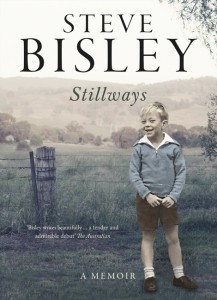
It’s familiar territory to me in many respects—I was born in Newcastle, and although I don’t remember living there, we visited friends every year from our holiday house at Macmasters Beach, a little further south than where Bisley grew up on Lake Munmorah. And he’s a bit older than me, too, born in 1950 and left school before I even started, but there’s still enough cross-over in our experiences for the memoir to ring many familiar bells with me. First of all the landscape—Bisley has a very Australian voice, and he has an easy and intimate memory of place, from the shearing sheds of his uncle’s farm at the back of Dubbo to the surfer-infested beaches of 1960s Central Coast. Also beautifully captured is the 50-50 dance, and the school social, with adults and kids alike responding to the erotic possibilities in both rock and roll and the progressive barn dance. There’s sex, or the hope of it, and death, quite a lot of it, grog and as the 60s take hold, dope. It’s also funny and wry and at times surprising in the dexterity and originality with which Bisley crafts an image or concept. He’s a writer, all right, but one obviously informed by his work as an actor, and his early passion for art—there are cadences in the language and images wrought by words that clearly come from these crafts.
And it’s a book, as so many Australian books seem to be, that interrogates masculinity; Bisley’s father comes across as not only damaged by his war experiences, but somehow thwarted in his own unrecognised desires. So, too, is Bisley’s mother. It’s obviously a deeply unhappy marriage, and the father is brutal, but it’s the relationship with his mother that lingers—her ‘closed heart’, even to her own children, but yet there is evident a clear and deep attachment between mother and son.
All of this underscores Bisley’s restless nature and his anxious desire to get out and away—and that’s where the book finishes. I can’t help but hope that we get to hang out with 16 year old Steve in Sydney, as he takes up his first job and his first love, the exciting Sue Green of the blue eyes, and eventually enters into the world of acting. Bravo—and encore!
Final note:
I expect I’ll be reading a lot more in this genre. I own heaps of memoir, particularly by writers, and I’ve dabbled a bit in the area myself, mostly, so far, on a blog I keep a little bit private. (Ask me if you’re seriously interested.) And I’m scratching out plans and ideas for a memoir of my own childhood reading set against—you guessed it—domestic architecture; the houses and places we lived. And my own mother, and father, will be in it, if it ever gets written, but I am pretty sure no-one will be pillorying me in the press for it. At least, I hope not. I mean, I don’t have anything mean I plan to say about them and after all, it’s mothers who usually cop such flack, rather than daughters, isn’t it…?
___________________________________________
*Curiously, the US edition subtitles The Lost Boy “A Mother’s Story.” And the NY Times review, to which I’ve linked, is nowhere near as harsh—not really harsh at all—on Meyerson. Perhaps that reflects a difference in attitudes towards confessionals, therapy and parenthood across the pond?
** I don’t know Steve Bisley, but I did meet him at the opening night party for this year’s Sydney Writers’ Festival. He still likes to dance.

